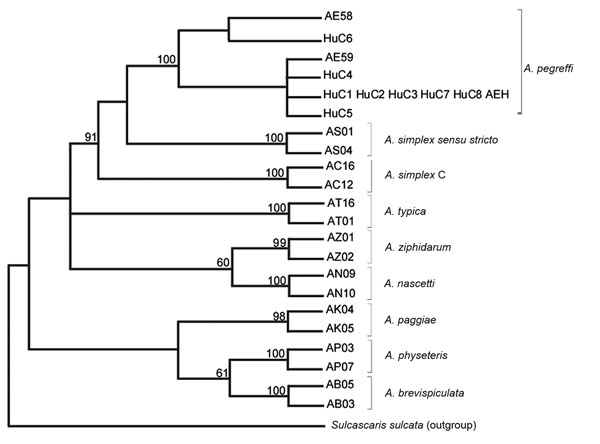Volume 19, Number 3—March 2013
Dispatch
Anisakiasis and Gastroallergic Reactions Associated with Anisakis pegreffii Infection, Italy
Figure 1

Figure 1. . . Maximum-parsimony bootstrap consensus tree inferred by PAUP* (12) for specimens of Anisakis pegreffii nematodes from patients with gastric anisakiasis (HuC1–HuC8) in Italy. Phylogenetic tree was obtained by mitochondrial DNA cox2 sequences analysis (629 bp) of 1,000 pseudoreplicates related to A. pegreffii previously sequenced and deposited in GenBank. AEH indicates A. pegreffii associated with a previously reported case of intestinal anisakiasis (7). Bootstrap values >70 are reported at the nodes. Sequences at the mitochondrial DNA cox2 shown here have been deposited in GenBank under accession nos: JQ900759, JQ900760, JQ900761, and JQ900762.
References
- Mattiucci S, Nascetti G. Advances and trends in the molecular systematics of anisakid nematodes, with implications for their evolutionary ecology and host–parasite co-evolutionary processes. Adv Parasitol. 2008;66:47–148 and. DOIPubMedGoogle Scholar
- Audicana MT, Kennedy MV. Anisakis simplex: from obscure infectious worm to inducer of immune hypersensitivity. Clin Microbiol Rev. 2008;21:360–9 and. DOIPubMedGoogle Scholar
- Daschner A, Cuéllar C, Rodero M. The Anisakis allergy debate: does an evolutionary approach help? Trends Parasitol. 2012;28:9–15 and. DOIPubMedGoogle Scholar
- Umehara A, Kawakami Y, Araki J, Uchida A. Molecular identification of the etiological agent of the human anisakiasis in Japan. Parasitol Int. 2007;56:211–5 and. DOIPubMedGoogle Scholar
- D’Amelio S, Mathiopoulos KD, Brandonisio O, Lucarelli G, Doronzo F, Paggi L. Diagnosis of a case of gastric anisakidosis by PCR-based restriction fragment length polymorphism analysis. Parassitologia. 1999;41:591–3 .PubMedGoogle Scholar
- Fumarola L, Monno R, Ierardi E, Rizzo G, Giannelli G, Lalle M, Anisakis pegreffii etiological agent of gastric infections in two Italian women. Foodborne Pathog Dis. 2009;6:1157–9 and. DOIPubMedGoogle Scholar
- Mattiucci S, Paoletti M, Borrini F, Palumbo M, Palmieri RM, Gomes V, First molecular identification of the zoonotic parasite Anisakis pegreffii (Nematoda: Anisakidae) in a paraffin-embedded granuloma taken from a case of human intestinal anisakiasis in Italy. BMC Infect Dis. 2011;11:82 and. DOIPubMedGoogle Scholar
- Valentini A, Mattiucci S, Bondanelli P, Webb SC, Mignucci-Giannone A, Colom-Llavina MM, Genetic relationships among Anisakis species (Nematoda: Anisakidae) inferred from mitochondrial cox2 sequences, and comparison with allozyme data. J Parasitol. 2006;92:156–66 and. DOIPubMedGoogle Scholar
- Zhu X, D’Amelio S, Paggi L, Gasser RB. Assessing sequence variation in the internal transcribed spacers of ribosomal DNA within and among members of the Contracaecum osculatum complex (Nematoda: Ascaridoidea: Anisakidae). Parasitol Res. 2000;86:677–83 and. DOIPubMedGoogle Scholar
- Thompson JD, Gibson TJ, Plewniak F, Geanmougin F, Higgins DG. The Clustal X windows interface: flexible strategies for multiple sequence alignment aided by quality analysis tools. Nucleic Acids Res. 1997;25:4876–82 and. DOIPubMedGoogle Scholar
- Mattiucci S, Paoletti M, Webb SC. Anisakis nascettii n. sp. (Nematoda: Anisakidae) from beaked whales of the southern hemisphere: morphological description, genetic relationships between congeners and ecological data. Syst Parasitol. 2009;74:199–217 and. DOIPubMedGoogle Scholar
- Swofford DL. PAUP*. Phylogenetic analysis using parsimony (*and other methods). v. 4. Sunderland, MA, USA: Sinauer Associates; 2003 [cited 2012 Dec 20]. http://paup.csit.fsu.edu
- Stallone O, Paggi L, Balestrazzi A, Mattiucci S, Montinari M. Gastric anisakiasis in Italy: case report. Med J Sur Med. 1996;4:13–6.
- Baldwin RE, Rew MB, Johansson ML, Banks MA, Jacobson KC. Population structure of three species of Anisakis nematodes recovered from Pacific sardines (Sardinops sagax) distributed throughout the California Current System. J Parasitol. 2011;97:545–54 and. DOIPubMedGoogle Scholar
- AAITO-IFIACI. Anisakis Consortium. Anisakis hypersensitivity in Italy: prevalence and clinical features: a multicenter study. Allergy. 2011;66:1563–9 and. DOIPubMedGoogle Scholar
Page created: February 12, 2013
Page updated: February 12, 2013
Page reviewed: February 12, 2013
The conclusions, findings, and opinions expressed by authors contributing to this journal do not necessarily reflect the official position of the U.S. Department of Health and Human Services, the Public Health Service, the Centers for Disease Control and Prevention, or the authors' affiliated institutions. Use of trade names is for identification only and does not imply endorsement by any of the groups named above.